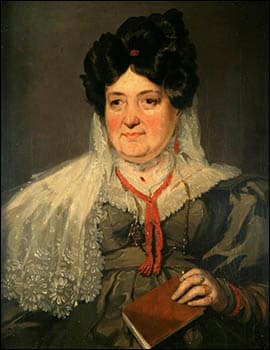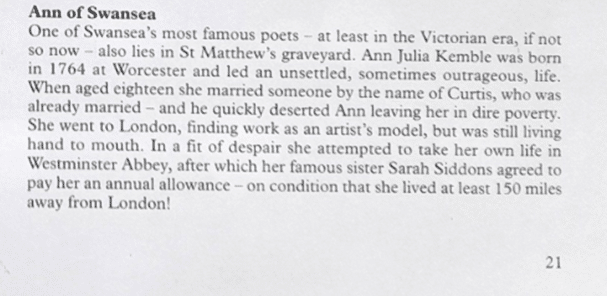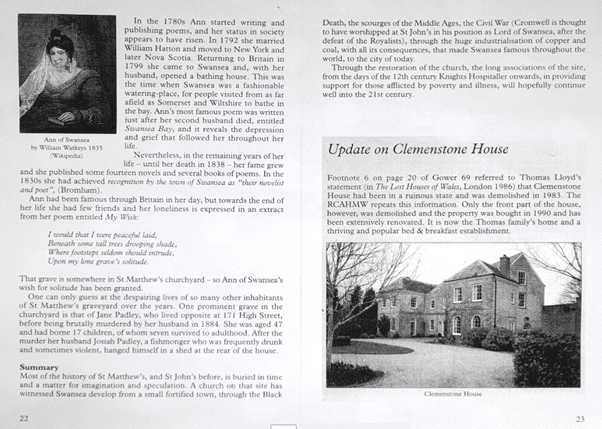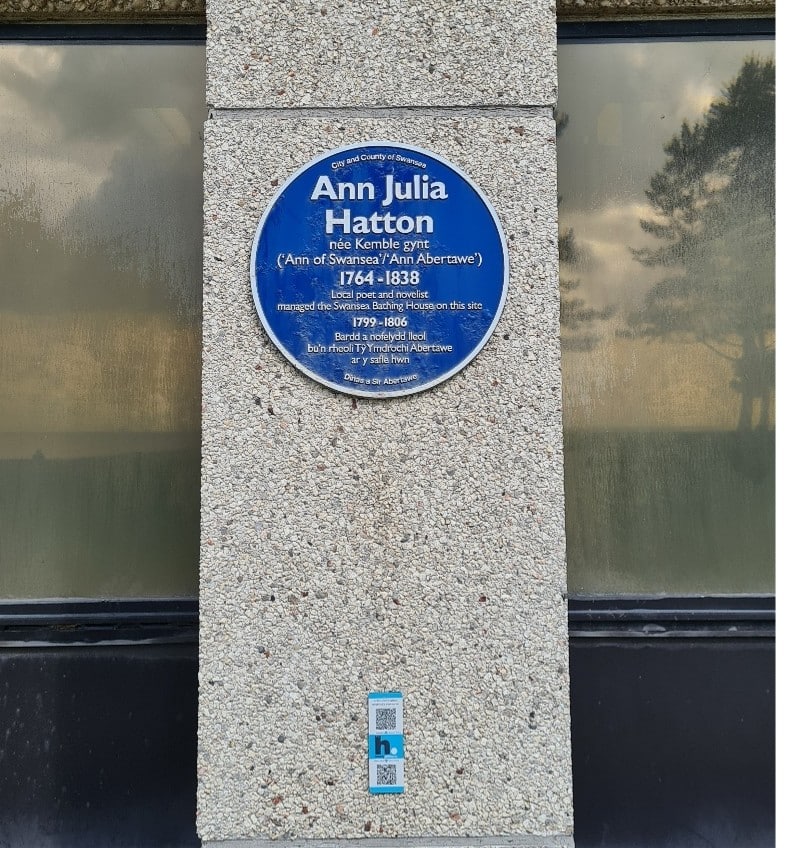Image: Swansea Ann Hatton Portrait
Trail point 9
Ann of Swansea

Ann of Swansea
Ann of Swansea: A Life in Letters and Legacy in Stone
Discover the extraordinary life of Ann Julia Kemble (1764–1838), known to literary history as Ann of Swansea, and her enduring connection to St Matthew’s Church and its graveyard.
Origins and Early Struggles
Ann Julia Kemble was born on 29 April 1764 in Worcester, into the celebrated Kemble theatrical family. She was the younger sister of Sarah Siddons, one of Britain’s most famed actresses, and John Philip Kemble, a renowned tragedian of the late 18th century. While her family took centre stage in London’s theatres, Ann’s life unfolded in the margins, a dramatic story shaped by misfortune, scandal, and reinvention.
Her early adulthood was marked by tragedy. After marrying an actor, C. Curtis, Ann discovered he was already married. Penniless and humiliated, she attempted suicide inside Westminster Abbey, an act that caught the attention of scandal sheets of the day. To survive, she reportedly worked in a London bagnio (brothel), where she suffered a gunshot wound to the face. These early experiences would later colour the emotional intensity and gothic edge of her writing.
Reinvention in America and Return to Wales
In 1792, Ann married William Hatton, and the couple emigrated to America, where she achieved literary success. Her libretto “Tammany: The Indian Chief” (1794) became the first known opera libretto written by a woman in America — a pioneering achievement. However, by 1799, Ann and William had returned to Swansea, where they ran a bathing house along the coast until William’s death in 1806.
Briefly relocating to Kidwelly, where she operated a dancing school until 1809, Ann soon returned to Swansea. There, she would adopt her enduring pseudonym: Ann of Swansea.
Literary Life in Swansea
Between 1809 and 1838, Ann became a prolific and respected literary figure in her adopted town. She published fourteen novels, numerous poems, and essays that explored gothic fiction, social satire, and moral storytelling. Writing for Minerva Press, her books included titles like Cambrian Pictures (1810), Chronicles of an Illustrious House (1816), and Guilty or Not Guilty (1822).
Her works were particularly popular among female readers and often explored themes of injustice, gender roles, class dynamics, and personal redemption. Drawing from her own painful experiences, she gave voice to the marginalised and exposed hypocrisy in fashionable society.
Despite her literary success, Ann lived modestly and was remembered by contemporaries as eccentric, fiercely intelligent, and unafraid to defy social convention.
Resting Place: St Matthew’s Church (formerly St John’s Juxta)
Ann of Swansea died on December 26, 1838, in Swansea. She was buried in the churchyard of St John-juxta-Swansea, later renamed St Matthew’s Church, located on High Street, at the heart of the modern Greenhill area. She remains here within the grounds, quietly marking the life of a woman who, through suffering and survival, became one of Swansea’s most remarkable literary figures.
The churchyard itself is rich with historical significance, containing the remains of individuals who shaped the area’s social, industrial, and cultural life. Ann’s presence here adds a layer of literary and feminist heritage, connecting the built environment to the written word.
Remembering Ann: Cultural Legacy
Ann of Swansea’s life has been increasingly recognised in recent decades as a vital part of Wales’ literary and women’s history. A blue plaque in her honour was installed at Swansea Civic Centre, ensuring her contributions are not forgotten.
Her portrait is held in Swansea Museum and the Glynn Vivian Art Gallery, while her novels have seen renewed academic interest — particularly among scholars of Romantic-era women writers and gothic literature.
Today, Ann’s story is told not only through her surviving works but also through this place and our heritage trail — a quiet testimony to resilience, creativity, and transformation.
Sources and References
- Watkins, Conrad. Crusaders, Cholera, Copper and Frankenstein – The Hidden History of St. Matthew’s Church, Gower Journal, Vol. 70 (2019), pp. 15–23.
Features accounts of Ann’s burial and her cultural significance in St Matthew’s graveyard. - Wikipedia – Ann Hatton (Ann of Swansea)
https://en.wikipedia.org/wiki/Ann_Hatton - Dictionary of Welsh Biography – Ann Julia Hatton (née Kemble)
https://biography.wales/article/s-HATT-ANN-1764 - Find a Grave – Memorial to Ann Julia Hatton
https://www.findagrave.com/memorial/224024595/ann-julia-hatton - Romantic Textualities – Revisiting Ann of Swansea
https://www.romtext.org.uk/articles/rt22_n06/ - Swansea Council – Ann of Swansea Blue Plaque
https://www.swansea.gov.uk/annofswanseablueplaque?lang=en





